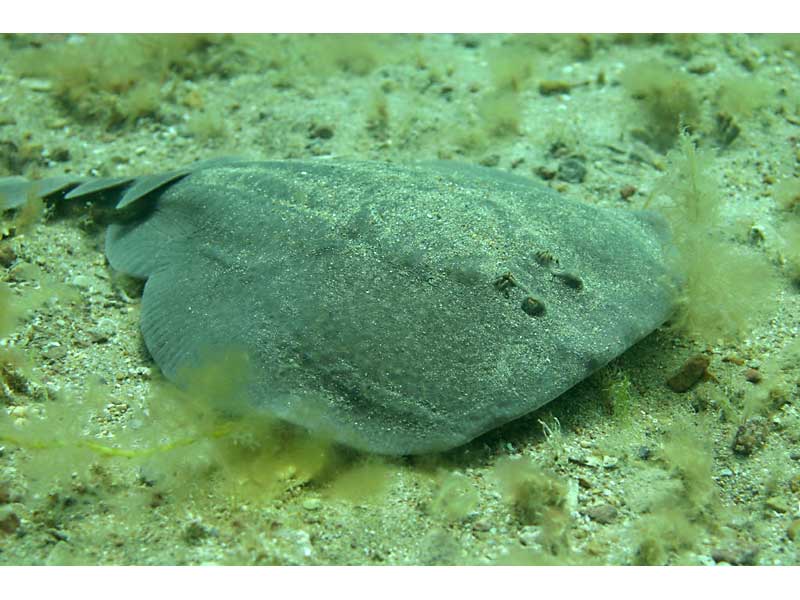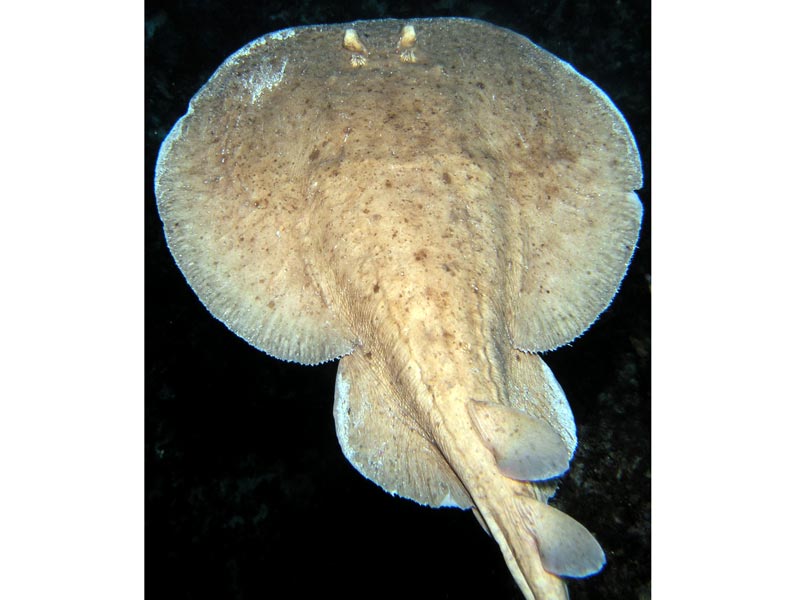Marbled electric ray (Torpedo marmorata)
Distribution data supplied by the Ocean Biodiversity Information System (OBIS). To interrogate UK data visit the NBN Atlas.Map Help
| Researched by | Morvan Barnes | Refereed by | This information is not refereed |
| Authority | Risso, 1810 | ||
| Other common names | - | Synonyms | Torpedo (Torpedo) marmorata |
Summary
Description
Recorded distribution in Britain and Ireland
Recorded all around the coasts of Britain and Ireland.Global distribution
Recorded from the Shetland Isles in the British Isles and the Atlantic coast of France, the Mediterranean, south along the Atlantic coast of Africa to South Africa and Madagascar.Habitat
The electric ray is a demersal species usually found on sandy or muddy seabeds at depths between 10-100 m. It is often buried during the day but will swim in search of prey at night.Depth range
10-100 mIdentifying features
- Up to 80 cm in length.
- Rounded disc-like body with a rounded snout.
- Short tail with broad caudal fin.
- Two dorsal fins positioned close together on the tail.
- Marbled pale and dark brown colouration.
- Seven papillae-like processes around the inner edge of spiracles.
Additional information
It can be distinguished from the electric ray Tetronarce nobiliana by the colouration which is marbled pale and dark brown in the marbled electric ray and dark greyish-blue to brown in Tetronarce nobiliana.
Electric rays are best known for their highly specialized electrogenic organs. They are generally kidney-shaped organs, composed of stacks of striated muscle plaques. All these plaques are enervated on the same side, so that any muscular contraction generates electricity. This ultimately produces an external shock, used by the electric rays to incapacitate prey or deter potential predators (Stehmann & Bürkel, 1984).
Listed by
Bibliography
Cadenat, J., Capapé, C. & Desoutter, M., 1978. Description d'un torpedinidae nouveau des cô tes occidentales d'Afrique: Torpedo bauchotae (Torpediniformes, Pisces). Cybium, 4, 29-42
Shark Trust, 2009. An Illustrated Compendium of Sharks, Skates, Rays and Chimaera. Chapter 1: The British Isles. Part 1: Skates and Rays. [Cited 06-07-2018] Available from https://www.sharktrust.org/fact-files
Stehmann, M. & Bürkel D.L., 1984. Torpedinidae. p. 159-162. In Fishes of the north-eastern Atlantic and Mediterranean (eds. P.J.P. Whitehead, M.-L. Bauchot, J.-C. Hureau, J. Nielsen and E. Tortonese). UNESCO, Paris.
Whitehead, P.J.P., Bauchot, M.-L., Hureau, J.-C., Nielson, J. & Tortonese, E. 1986. Fishes of the North-eastern Atlantic and the Mediterranean. Vol. I, II & III. Paris: United Nations Educational, Scientific and Cultural Organisation (UNESCO).
Datasets
Isle of Wight Local Records Centre, 2017. IOW Natural History & Archaeological Society Marine Records. Occurrence dataset: https://doi.org/10.15468/7axhcw accessed via GBIF.org on 2018-09-27.
NBN (National Biodiversity Network) Atlas. Available from: https://www.nbnatlas.org.
OBIS (Ocean Biodiversity Information System), 2025. Global map of species distribution using gridded data. Available from: Ocean Biogeographic Information System. www.iobis.org. Accessed: 2025-07-30
Citation
This review can be cited as:
Last Updated: 22/05/2008




